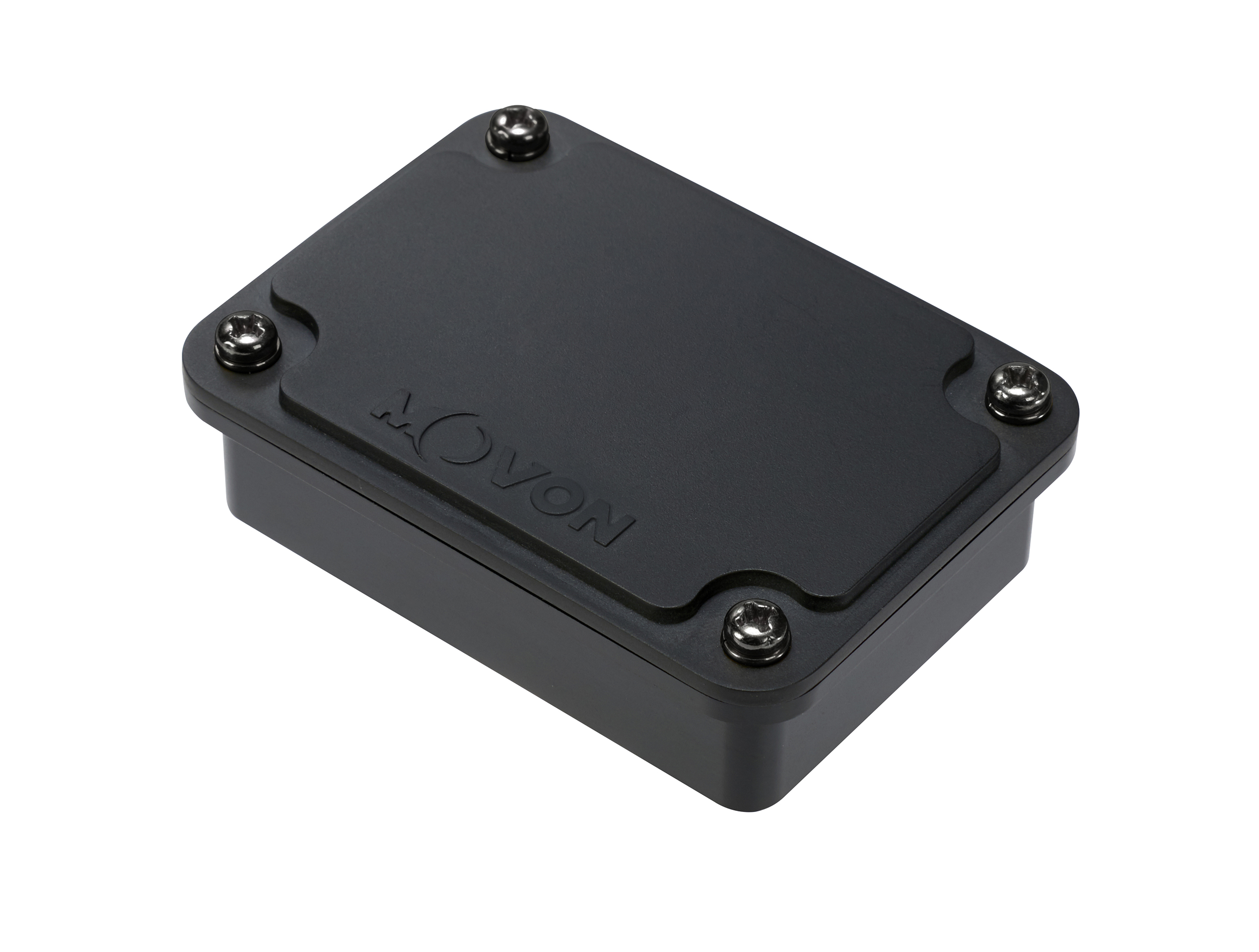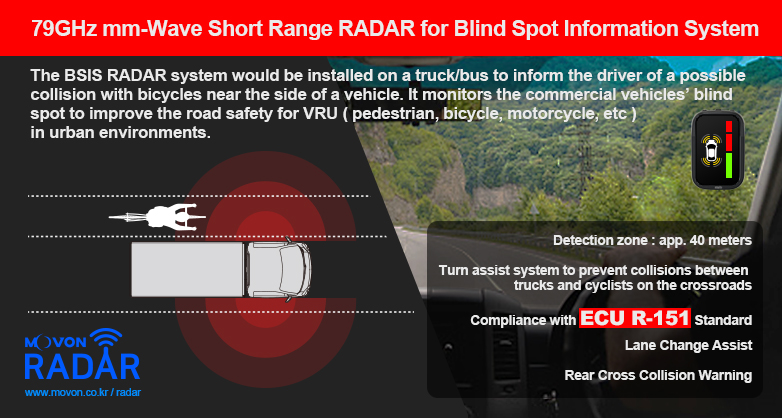Contact Us
Our team of product experts can help you find the best solution for your company.
Movon Corporation was founded as a testing laboratory office of Cetecom Germany in Seoul, Korea in 1998.
Wireless R&D center established in 2001. The first Bluetooth module launched in 2002, and became a Tier-2 supplier for General Motors.
Advanced Driver Assistance System business unit established in 2010 based on cutting edge computer vision perceoption solutions (afforable but powerful) on embedded systems.
Patented in-house solutions : Lane Departure Warning (LDW), Forward Collision Warning (FCW), Pedestrian Collision Warning (PCW) and Driver Drowsiness and Attention Warning ( DDAW ).
A Tier-1 supplier for TATA Daewoo Commercial Vehicle, and supplied OEM ADAS and DDAW .
Expansion of AI-sensor-based driver safety products and road safety system for commercial vehicle in 2018.
Unveiled the RADAR-based Driver safety products such as Blind Spot Detection and Warning as well as Vision-RADAR Fusion system.
MOVON Corporation creates an environmentally friendly workplace that meets the optimal environmental conditions required,
complies with environmental regulations through continuous environmental improvement, and contributes to the community
and customers through enterprise-wide environmental management activities.
ISO 14001 CERTIFIED

Dear valuable distributors and partners |
| 79GHz RADAR is a type of millimeter-wave RF that is used in automotive applications. The short range radar is suitable for detecting cars, motorcycles and cyclists as well as pedestrians. It has high resolution and robustness at nighttime and in bad weather. |

7 Seolleung-ro 94-gil, Gangnam-gu, Seoul, 06161, Korea
Movon MOIS ( Moving Off Information System ) warns a driver of the presence of pedestrians and cyclists at the critical blind spot area in front of a vehicle at 0~10kmh. 79GHz RADAR sensors make use of millimeter wave to detect and calculate the distance between the car and VRUs in front of the truck. RADAR senso would be placed on the front hood of the truck to ensure that the millimeter wave can travel uninterrupted. This MOIS alerts the driver by visual and audio alarming; as the car moves closer to VRU ( Vulnerable Road Users ) in front blind spot zone, the beeping sound could be generated to inform a driver of the impending collision danger. ECE R159 : this Regulation requires the activation of a proximity information signal in case pedestrians or cyclists enter the critical blind spot area in front of the vehicle, should the subject vehicle either be preparing to move off from rest in a straight line or be travelling straight ahead at low-speeds.

Dear Valuable Distributors and Partners
|
We are displaying the DDAW System of AI-powered Driver Safety and Monitoring Products, and exhibiting the BSIS System of 79GHz mmWave RADAR-powered Road Safety Products. |

7 Seolleung-ro 94-gil, Gangnam-gu, Seoul, 06161, Korea
Movon BSIS system uses 79GHz Short Range RADAR ( SRR ) to detect VRUs and vehicles on the side of the vehicle and warns a driver at the impending collision risk. In accordance with EU R151 regulations, RADAR units are attached to the left and right sides of the vehicle to detect VRU within total 40 meters from about 20meters behind the vehicle to about 10 meters ahead of the front bumper. If there is a collision risk, the indicator attached to the A-pillar is showing a visual alarm and a voice warning is issued through a speaker installed in the vehicle. BSISI warning is generated at the lower driving speed or standstill in an urban road environment where there are many bicycles and pedestrians. When the speed exceeds 30Km, the Lane Change Assist function is activated, and when there is a vehicle in the next lane when changing lanes, the driver is notified visually and audibly to assist in changing lanes safely.

Increased use of public bicycles and escooters
Driving on and off roads and sidewalks
91 deaths last year... 30% surge ( source : https://www.hankyung.com/society/article/2023061996321 )
Frequent 'side collision' accidents with cars
Be careful when entering the alley → road
On the afternoon of the 19th, at the Yeouido Transfer Center in Yeouido-dong, Seoul. Several taxis were waiting for customers occupying the 1.5m-wide bicycle road paved with red urethane. An office worker who rode the Seoul public bicycle “Ttareungi” without a helmet ran acrobaticly to avoid illegally parked taxis. Another cyclist went up to the sidewalk and then went back to the traffic island and almost collided with a passing car. Mr. Seo (31), an office worker, said, "Urban cyclists are inevitably at risk of accidents while traveling between sidewalks, roads, and traffic islands."
With the number of bicycle users nationwide exceeding 13 million, the damage caused by bicycle traffic accidents is rapidly increasing. In addition to the existing bicycles, new means of transportation such as electric bicycles and kickboards have emerged, resulting in a 30% increase in the number of deaths due to bicycle accidents compared to the previous year.
30% increase of bicycle fatalities
According to the National Police Agency on the same day, the number of deaths in bicycle accidents last year was 91, the highest since 2017. This is a 30% increase from the previous year (70 people). Police believe the actual death toll may be more than 100. This is because many cases are handled without being reported to the police.
As of this year, 18 people have died as of April. On the 16th, Joo Joong-joong, a professor of cardiovascular and thoracic surgery at Asan Medical Center in Seoul, who is called “aortic surgeon”, died in a traffic accident while riding a bicycle. It is known that the truck driver who was turning right did not see Professor Joo, who was crossing the crosswalk near the traffic island on his bicycle.
Many of the bicycle deaths are collisions between cars and bicycles, as in Professor Zhu's case. According to the National Statistics Portal’s ‘Status of Bicycle Traffic Accidents by Accident Type’, out of 5509 bicycle-related accidents that occurred in 2021, collisions between cars and bicycles accounted for an overwhelming proportion of 3992 cases (72.6%). That's an average of 10 or more cases per day. Among them, side collisions were the most common with 1944 cases. This is a type of accident in which a bicycle enters the road from an alley or collides with a vehicle coming from a crosswalk. There were also 26 deaths.
Accidents involving scooters and electric bicycles are also serious.
Although the means of transportation that did not exist are evolving rapidly, there are many cases where civic consciousness or legal systems cannot keep up. An example is an electric bicycle equipped with an electric motor on a bicycle. The police explained that the degree of injury in the event of an accident is serious because it can run up to 25 km per hour. However, only a portion of e-bikes are counted as bicycle accidents. Even for electric bicycles, throttle-type bicycles that operate the motor by turning the lever with your hands without stepping on the pedals are classified as personal mobility devices (PM) and are subject to the Road Traffic Act. This means that it is missing from the bicycle accident statistics. On the other hand, PAS (Pedal-Assisted) type electric bicycles, whose motor operates only when the pedals are turned, are subject to the Bicycle Act.
Accidents with shared kickboards, which are frequently used by teenagers, are also on the rise. According to data from the National Police Agency, there were 2,386 scooter accidents last year, with 26 deaths. In particular, the number of accidents involving personal mobility devices for teenagers under the age of 19 recorded 1,096 last year. It increased by about 44 times the 25 cases in 2018. Police attribute more than 90% of accidents to kickboard accidents.
Experts advised that safety measures should be put in place for cyclists who are not welcome on both roads and sidewalks. Lee Jae-young, a senior researcher at the Daejeon Sejong Institute (executive director of the Korea Bicycle Policy Association), said, “In addition to the expansion of bicycle-only roads, a separate transportation policy for bicycles is needed.” It is also urgent,” he pointed out.
Our team of product experts can help you find the best solution for your company.